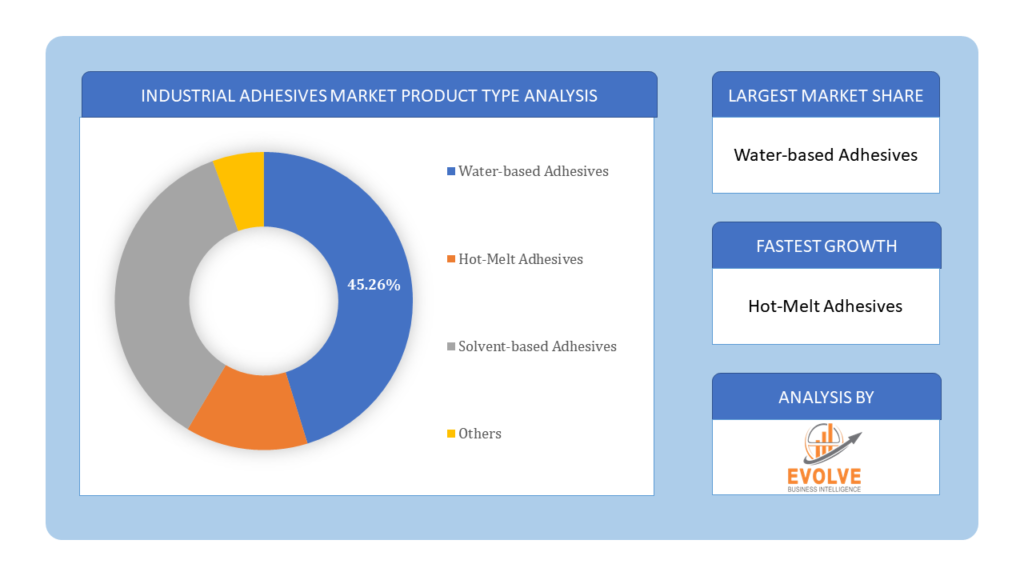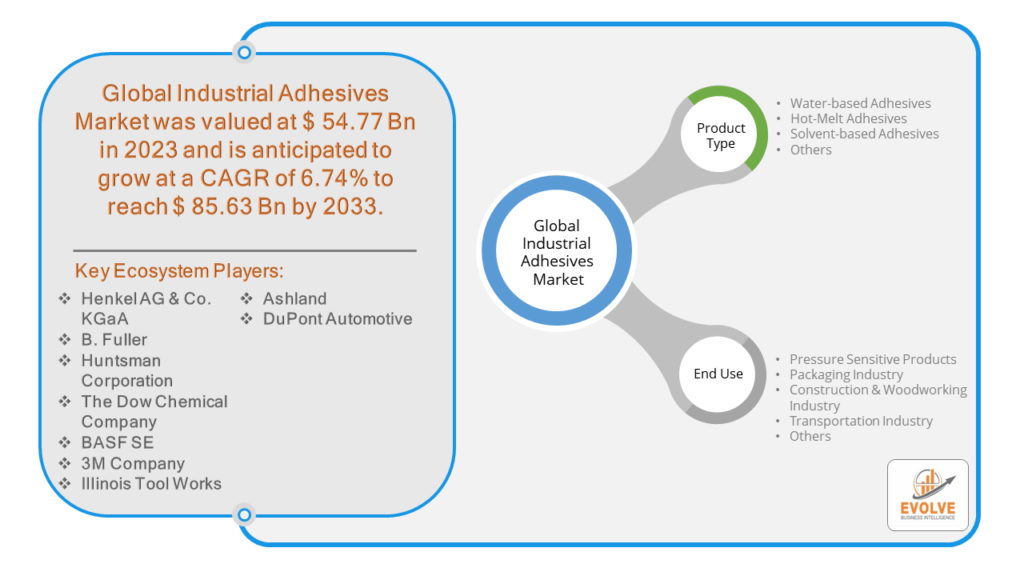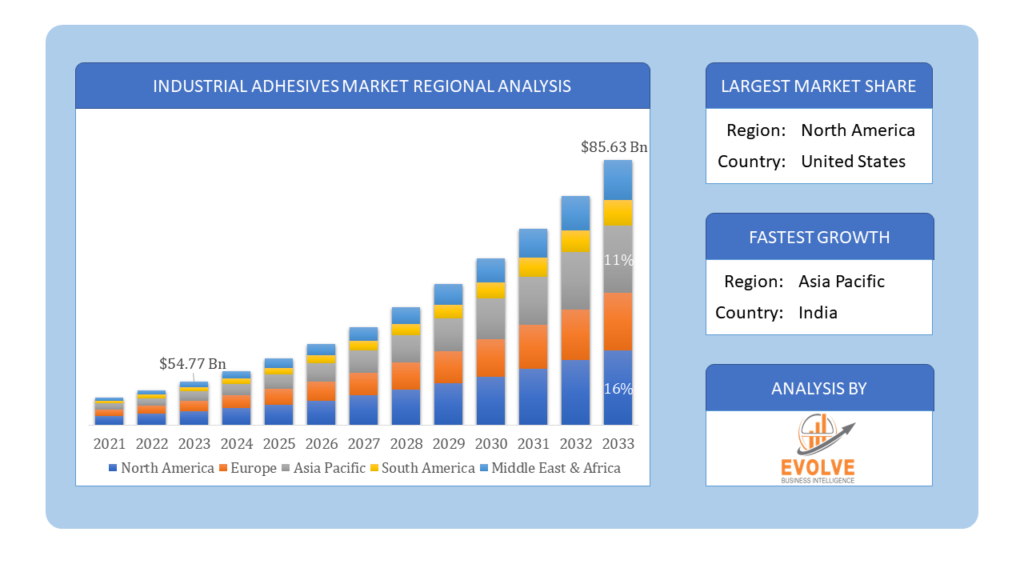Industrial Adhesives Market Overview
The Industrial Adhesives Market Size is expected to reach USD 85.63 Billion by 2033. The Industrial Adhesives Market industry size accounted for USD 54.77 Billion in 2023 and is expected to expand at a compound annual growth rate (CAGR) of 6.74% from 2023 to 2033. The Industrial Adhesives Market refers to the sector that produces and sells adhesives used in industrial applications. These adhesives are substances applied to surfaces to bond them together. These adhesives are used to bond a wide variety of materials together, including metals, plastics, wood, and rubber. They are used in a wide range of industries, including automotive, construction, packaging, and electronics.
The Key factors driving the growth of the industrial adhesives market are increasing demand for lightweight and durable materials in the automotive and aerospace industries. The growing demand for convenience products, such as disposable diapers and food packaging
Global Industrial Adhesives Market Synopsis
The COVID-19 pandemic had a significant impact on the Industrial Adhesives Market. Lockdowns and restrictions led to interruptions in the supply of raw materials, causing delays and shortages. Manufacturing facilities had to implement safety measures, leading to reduced workforce availability and lower production capacity. The packaging industry saw a rise in demand due to the surge in e-commerce and home deliveries. The pandemic accelerated the focus on sustainability, leading to increased demand for eco-friendly and sustainable adhesive solutions. Manufacturers invested in R&D to develop adhesives with lower environmental impact. Companies adopted digital solutions and automation to enhance production efficiency and manage supply chain disruptions. There was an increased emphasis on innovative adhesive formulations to meet changing market needs.
Industrial Adhesives Market Dynamics
The major factors that have impacted the growth of Industrial Adhesives Market are as follows:
Drivers:
Ø Growing Construction Industry
Increasing investments in infrastructure projects, residential and commercial buildings, and renovations boost the demand for adhesives used in construction materials, flooring, paneling, and insulation. The automotive industry’s shift towards lightweight materials to improve fuel efficiency and reduce emissions increases the use of adhesives over traditional mechanical fasteners. Ongoing research and development lead to the creation of innovative adhesive formulations that offer superior bonding, durability, and performance. The adoption of automation and digital technologies in manufacturing processes enhances the efficiency and precision of adhesive application. Rapid industrialization and economic growth in emerging markets increase the demand for adhesives across various industries, including automotive, construction, and electronics.
Restraint:
- Perception of Fluctuating Raw Material Prices
Prices of raw materials used in adhesive production, such as petrochemicals, can be highly volatile due to factors like geopolitical tensions, supply chain disruptions, and changes in crude oil prices. Fluctuating raw material costs can lead to increased production expenses, which may be passed on to end-users or absorbed by manufacturers, impacting profitability. Economic downturns and uncertainty can lead to reduced industrial activity, postponement of projects, and decreased demand for adhesives in key sectors such as construction and automotive. The industrial adhesives market relies on global supply chains for raw materials and components. Disruptions due to natural disasters, geopolitical issues, or pandemics can impact production and delivery.
Opportunity:
⮚ Growing demand for Sustainability and Eco-Friendly Products
Developing adhesives with low volatile organic compounds (VOCs) and eco-friendly formulations to meet increasing environmental regulations and consumer demand for sustainable products. Innovations in adhesives that facilitate recycling and support the circular economy can attract environmentally conscious industries and consumers. Rapid industrial growth and urbanization in emerging economies present opportunities for increased demand for adhesives in construction, automotive, and electronics sectors. The rise of electric vehicles and hybrid cars increases the need for adhesives in battery assembly, lightweight materials, and electronic components. Continued focus on reducing vehicle weight to improve fuel efficiency and reduce emissions drives the demand for advanced adhesives that can replace mechanical fasteners.
Industrial Adhesives Market Segment Overview
By Product Type
 Based on Product Type, the market is segmented based on Water-based Adhesives, Hot-Melt Adhesives, Solvent-based Adhesives and Others. The Water-based Adhesives segment dominant the market. Environmentally friendly adhesive formulations include water-based adhesive technology since they do not contain Volatile Organic Compounds (VOC), hence, water-based adhesives are safe for both people and the environment. Pressure-sensitive adhesives made of water have a flexible open time and high amounts of tack.
Based on Product Type, the market is segmented based on Water-based Adhesives, Hot-Melt Adhesives, Solvent-based Adhesives and Others. The Water-based Adhesives segment dominant the market. Environmentally friendly adhesive formulations include water-based adhesive technology since they do not contain Volatile Organic Compounds (VOC), hence, water-based adhesives are safe for both people and the environment. Pressure-sensitive adhesives made of water have a flexible open time and high amounts of tack.
By End User
Based on End User, the market segment has been divided into the Pressure Sensitive Products, Packaging Industry, Construction & Woodworking Industry, Transportation Industry and Others. The Packaging Industry segment anticipated to dominant the market. The paper and packaging industries depend heavily on adhesives and sealants. Adhesives are used to line food containers such as beverage cans, laminate paper and cardboard, and glue labels. As more businesses choose sustainability and low environmental impact, hot melt and aqueous packaging and paper adhesives are taking over a larger and larger portion of the market which is driving revenue growth of the segment.
Global Industrial Adhesives Market Regional Analysis
Based on region, the global Industrial Adhesives Market has been divided into North America, Europe, Asia-Pacific, the Middle East & Africa, and Latin America. North America is projected to dominate the use of the Industrial Adhesives Market followed by the Asia-Pacific and Europe regions.
 Industrial Adhesives North America Market
Industrial Adhesives North America Market
North America holds a dominant position in the Industrial Adhesives Market. North America region is a mature market with well-established players. Growth here is driven by the increasing demand for high-performance adhesives in various industries, such as aerospace and construction. Technological advancements and innovation in adhesive formulations. High demand from the construction sector, driven by renovation and infrastructure projects.
Industrial Adhesives Asia-Pacific Market
The Asia-Pacific region has indeed emerged as the fastest-growing market for the Industrial Adhesives Market industry. Rapidly growing market driven by industrialization, urbanization, and economic development. Significant investments in infrastructure and construction projects. Increasing demand for electronics and consumer goods, driving the need for advanced adhesives.
Competitive Landscape
The global Industrial Adhesives Market is highly competitive, with numerous players offering a wide range of software solutions. The competitive landscape is characterized by the presence of established companies, as well as emerging startups and niche players. To increase their market position and attract a wide consumer base, the businesses are employing various strategies, such as product launches, and strategic alliances.
Prominent Players:
- Henkel AG & Co. KGaA
- B. Fuller
- Huntsman Corporation
- The Dow Chemical Company
- BASF SE
- 3M Company
- Illinois Tool Works
- Ashland
- DuPont Automotive
Scope of the Report
Global Industrial Adhesives Market, by Product Type
- Water-based Adhesives
- Hot-Melt Adhesives
- Solvent-based Adhesives
- Others
Global Industrial Adhesives Market, by End User
- Pressure Sensitive Products
- Packaging Industry
- Construction & Woodworking Industry
- Transportation Industry
- Others
Global Industrial Adhesives Market, by Region
- North America
- US
- Canada
- Mexico
- Europe
- UK
- Germany
- France
- Italy
- Spain
- Benelux
- Nordic
- Rest of Europe
- Asia Pacific
- China
- Japan
- South Korea
- Indonesia
- Austalia
- Malaysia
- India
- Rest of Asia Pacific
- South America
- Brazil
- Argentina
- Rest of South America
- Middle East & Africa
- Saudi Arabia
- UAE
- Egypt
- South Africa
- Rest of Middle East & Africa
| Parameters | Indicators |
|---|---|
| Market Size | 2033: $85.63 Billion |
| CAGR | 6.74% CAGR (2023-2033) |
| Base year | 2022 |
| Forecast Period | 2023-2033 |
| Historical Data | 2021 |
| Report Coverage | Revenue Forecast, Competitive Landscape, Growth Factors, and Trends |
| Key Segmentations | Product Type, End User |
| Geographies Covered | North America, Europe, Asia-Pacific, Latin America, Middle East, Africa |
| Key Vendors | Henkel AG & Co. KGaA, B. Fuller, Huntsman Corporation, The Dow Chemical Company, BASF SE, 3M Company, Illinois Tool Works, Ashland and DuPont Automotive. |
| Key Market Opportunities | • The growing demand for Sustainability and Eco-Friendly Products • Expansion in Emerging Markets |
| Key Market Drivers | • Growing Construction Industry • Technological Innovations |
REPORT CONTENT BRIEF:
- High-level analysis of the current and future Industrial Adhesives Market trends and opportunities
- Detailed analysis of current market drivers, restraining factors, and opportunities in the future
- Industrial Adhesives Market historical market size for the year 2021, and forecast from 2023 to 2033
- Industrial Adhesives Market share analysis at each product level
- Competitor analysis with detailed insight into its product segment, Government & Defense strength, and strategies adopted.
- Identifies key strategies adopted including product launches and developments, mergers and acquisitions, joint ventures, collaborations, and partnerships as well as funding taken and investment done, among others.
- To identify and understand the various factors involved in the global Industrial Adhesives Market affected by the pandemic
- To provide a detailed insight into the major companies operating in the market. The profiling will include the Government & Defense health of the company’s past 2-3 years with segmental and regional revenue breakup, product offering, recent developments, SWOT analysis, and key strategies.








